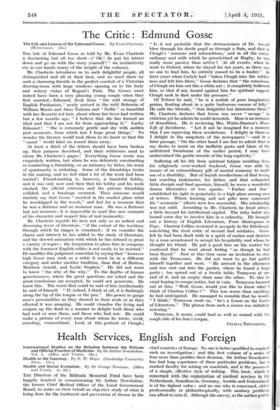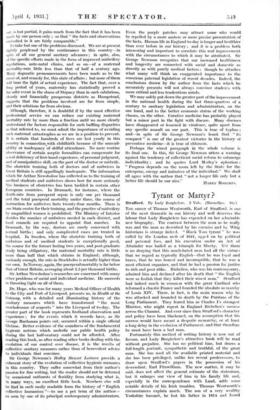Health Services, English and Foreign
International Studies on the Relation between the Private and Official Practice of Medicine. By Sir Arthur Newsholme. Vol. I. (Allen and Unwin. 168.) Health and Social Evolution. By Sir George Newman. (Allen and Unwin. 4s. 6d.) Tun Directors of the Millbank Memorial Fund have been happily inspired in commissioning Sir Arthur Newsholme, the former Chief Medical Officer of the Local Government Board, to make on their behalf an objective study of what is being done for the treatment and prevention of disease in the chief countries of Europe. No one is better qualified to conduct, such an investigation ; and this first volume of a series of four more than justifies their decision. Sir Arthur Newsholme has had long experience - of these particular problems, has a marked faculty for seizing on essentials, and is the possessor of a simple, effective style of writing. This book, which is concerned with the organization of medical services in the Netherlands, Scandinavia, Germany, Austria and Switzerland, is of the highest value ; and no one who is concerned, either professionally or philanthropically, with sanitary problems can afford to miss it. Although the survey; as the author points out, is but partial, it gains much from the fact that it has been made by one person only ; so that " the facts and observations embodied in it are fairly comparable."
To take but one of the problems discussed. We are at present rightly perplexed by . the continuance in this country—in spite of all our general sanitary advances ; in spite, also, of the specific efforts made in the form of improved midwifery regulations, ante-natal clinics, and so on—of a maternal mortality-rate little less than that - of half a century ago. Many dogmatic pronouncements have been made as to the cause of, and remedy for, this state of affairs ; but none of them will bear the light of actual experience. The fact that, over a long period of years, maternity has statistically proved a far safer event in the slums of Stepney than in such salubrious, cleanly and financially prosperous districts as Hampstead, suggests that the problems involved are far from simple, and their solutions far from obvious.
Although, therefore, it is doubtful if by the most effective professional service we can reduce our existing maternal mortality rate by more than a fraction until we more clearly understand the factors responsible for such baffling disparities as that referred to, we must admit the importance of avoiding such maternal catastrophes as we are in a position to prevent. It is certain that hundreds of lives are lost yearly in this country in connection.with childbirth because of the unavail- ability or inadequacy of skilful attendance. No mere routine observance of certain aseptic formalities can compensate for a real deficiency of first-hand experience, of personal judgment, and of manipulative skill, on the part of the doctor or midwife. The obstetric training both of doctors and of midwives in Great Britain is still appallingly inadequate. The information which Sir Arthur Newsholme has collected as to the training of medical students and midwives shows how far more seriously this business of obstetrics has been tackled in certain other European countries. In Denmark, for instance, where the death-rate from puerperal sepsis is only one per thousand and the total puerperal mortality under three, the course of instruction for midwives lasts twenty-four months. There is one State centre for their training, and the practice of midwifery by unqualified women is prohibited. The Ministry of Interior decides the number of midwives needed in each district, and local councils are required to appoint that number. In Denmark, by the way, doctors are rarely concerned with normal births ; and only complicated cases are treated in hospital. In Sweden, where the obstetric training both of midwives and of medical students is exceptionally good, the course for the former lasting two years, and post-graduate study being obligatory, the maternal mortality rate is little more than half that which obtains in England ; although, curiously enough, the rate in Stockholm is actually higher than our own. In Norway, again, the puerperal mortality is far below that of Great Britain, averaging about 2.5 per thousand births.
Sir Arthur Newsholme's researches are concerned with many other problems of social and individual medicine. He succeeds in throwing light on all of them.
Dr. Hope, who was for many years Medical Officer of Health to the City and Port of Liverpool, presents us, in Health at the Gateway, with a detailed and illuminating history of the sanitary measures which have transformed " the most unwholesome of seaports " into the Liverpool of to-day. The greater part of the book represents firsthand observation and experience ; for the events which it records have, as Sir George Buchanan points out; occurred within a single official lifetime. Better evidence of the soundness of the fundamental hygienic notions which underlie our public health policy during the last half-century could not be afforded. After reading this book, as after reading other books dealing with the evolution of our control over disease, it is the results of collective sanitary measures rather than of benevolent advice to individuals that convince.
Sir George Newman's Halley Stewart Lectures provide a coherent story of the evolution of collective hygienic measures in this country. They suffer somewhat from their author's passion for fine writing, but the reader should not be deterred by occasional outbursts of floridity from studying what is, in many ways, an excellent little book. Nowhere else will he find in such easily readable form the history of " English collective humanism "—to use a pet term of the author— as seen by one of. its principal contemporary administrators.
Even the purple patches may attract some who would he repelled by a more austere or more precise presentation of the facts. Human life in England to-day is longer and healthier than ever before in our history ; and it is a problem both interesting and important to correlate this real improvement with the circumstances to which it may be attributed. Sir George Newman recognizes that our increased healthiness and longevity are connected with social and domestic as directly as with purely medical factors ; though he attaches what many will think an exaggerated importance to the conscious paternal legislation of recent decades. Indeed, the conclusions drawn by the author from the facts which he accurately presents will not always convince students with more critical and less tendentious minds.
We may safely put down the greater part of the improvement in the national health during the last three-quarters of a century to sanitary legislation and administration, on the one hand, and to the better economic status of the working classes, on the other. Curative medicine has probably played but a minor part in the fight with disease. Many diseases have disappeared or lessened in virulence, quite apart from any specific assault on our part. This is true of typhus ; and—in spite of Sir George Newman's boast that " its conquest " is one of the greatest victories in the history of preventive medicine—it is true of chlorosis.
Perhaps the wisest paragraph in the whole volume is its final one. In this, Sir George Newman utters a warning against the tendency of collectivist social reform to submerge individuality ; and he quotes Lord Morley's aphorism : " Progress depends on the room left by the State for the enterprise, energy and initiative of the individual." We shall all agree with the author that " not a longer life only but a better life should be our aim."
HARRY ROBERTS.











































 Previous page
Previous page